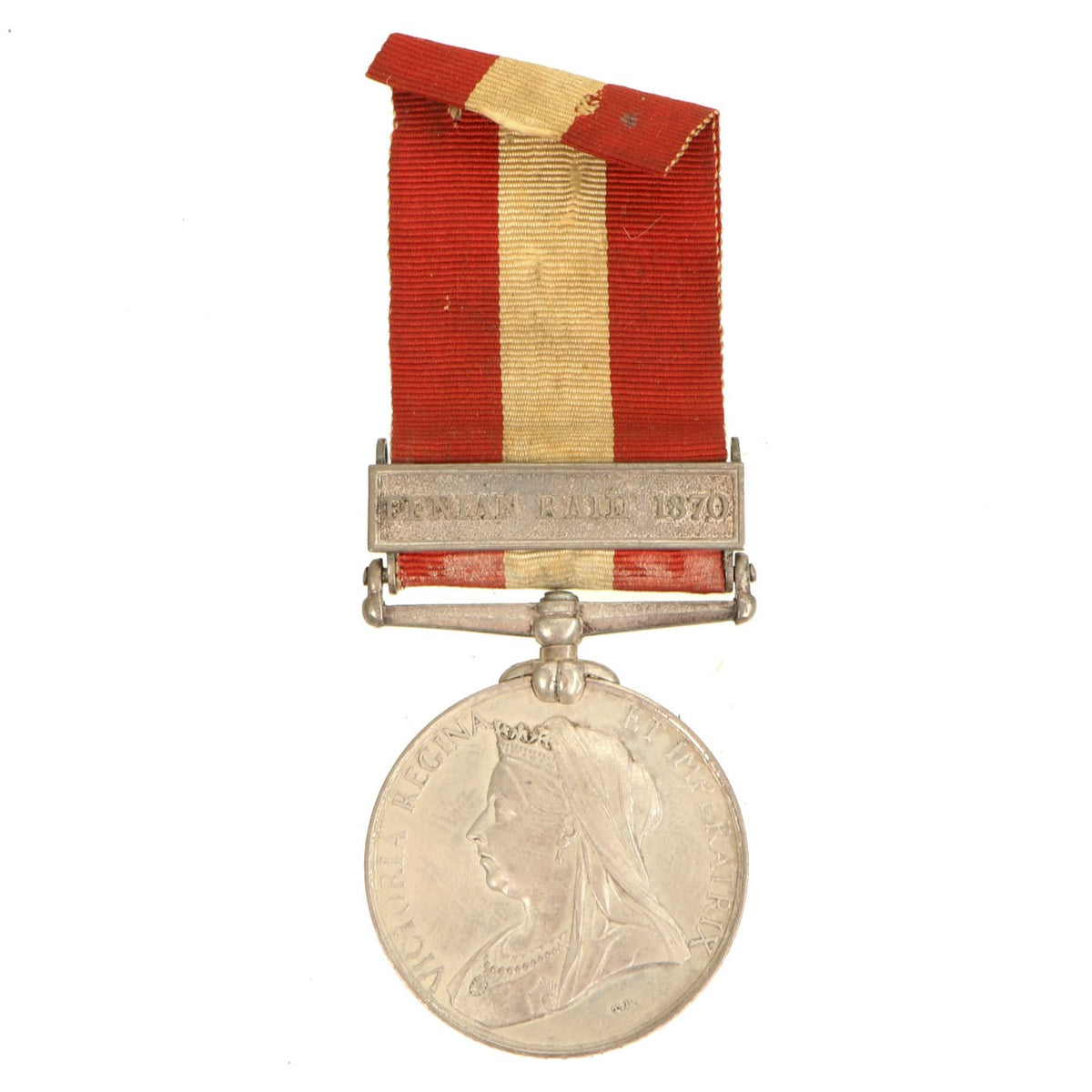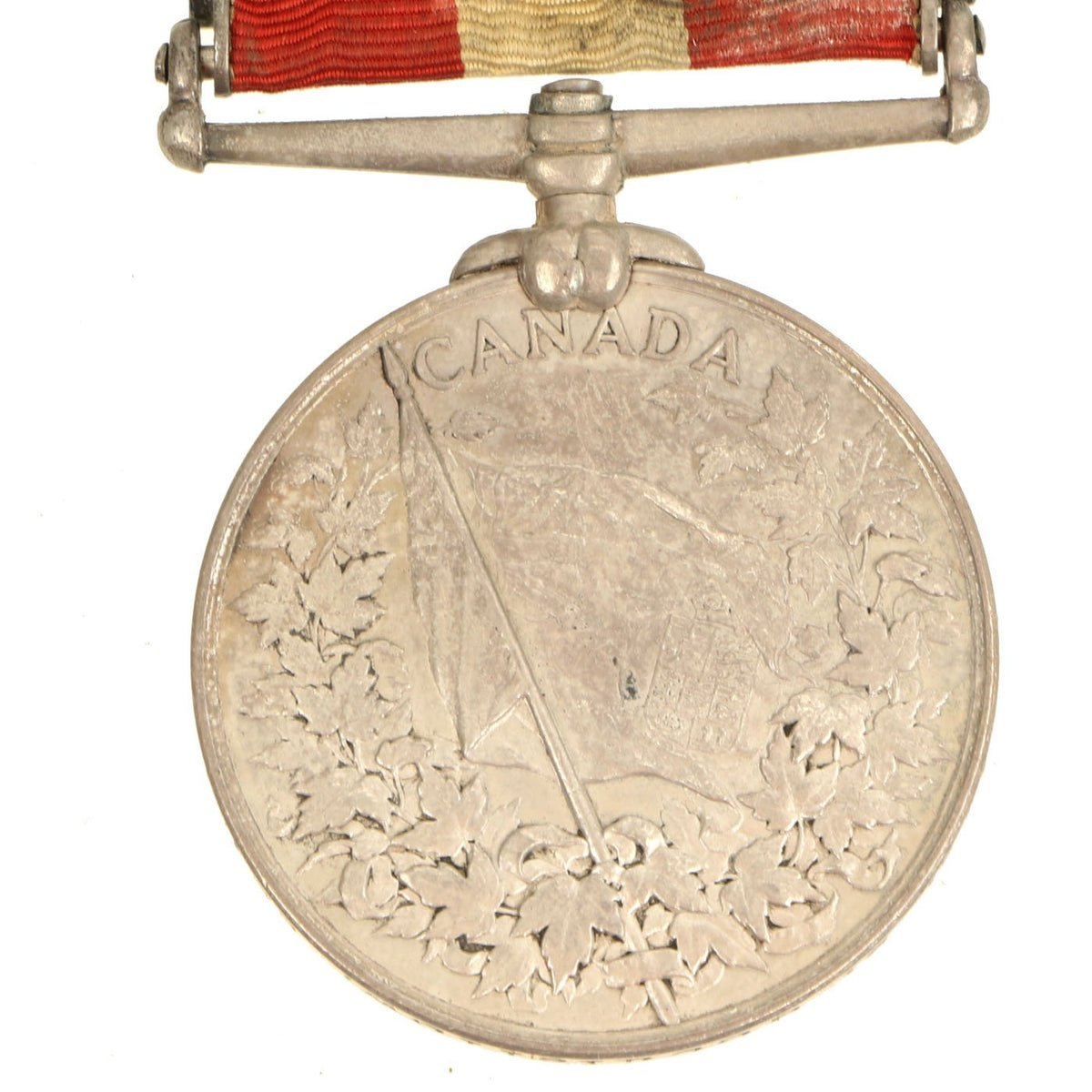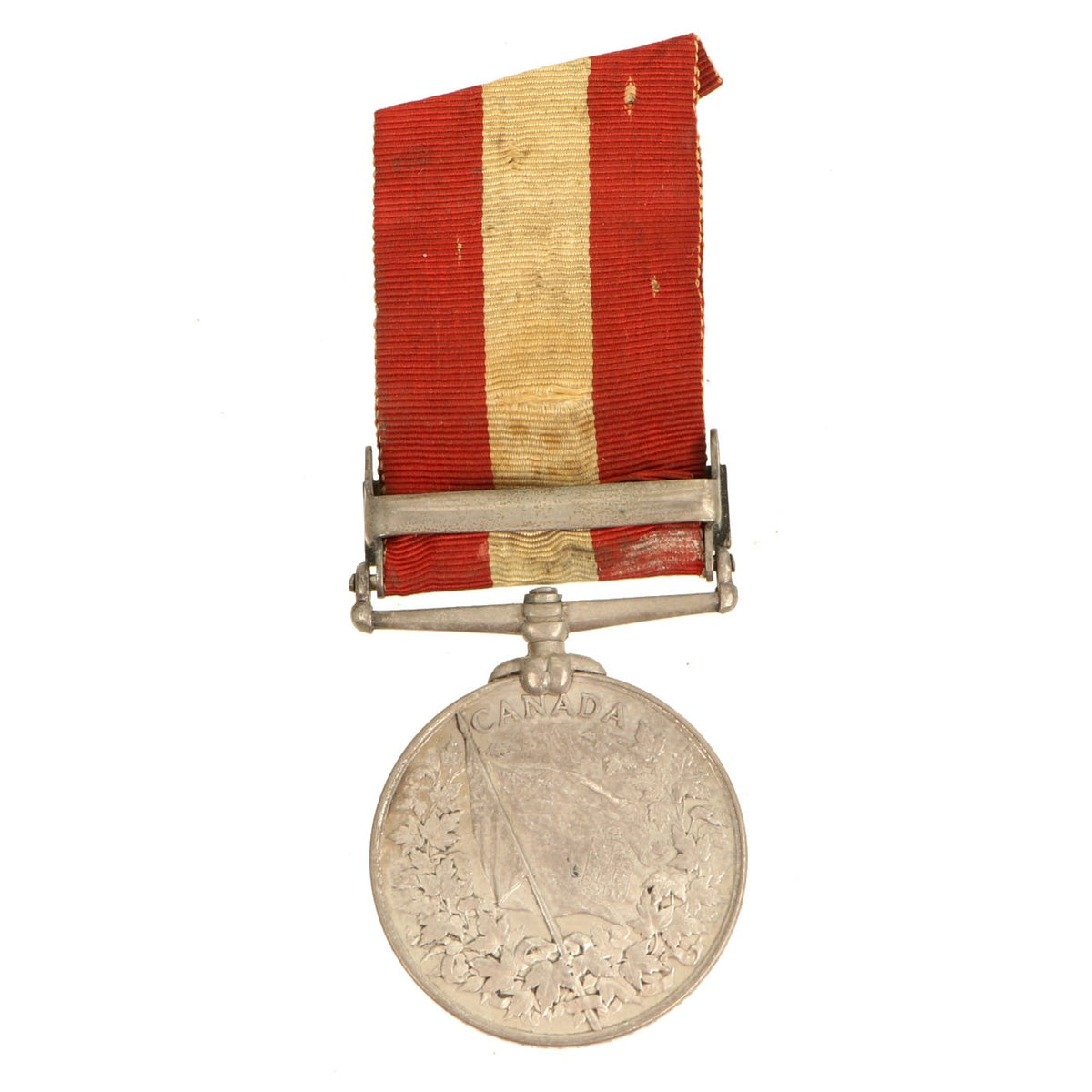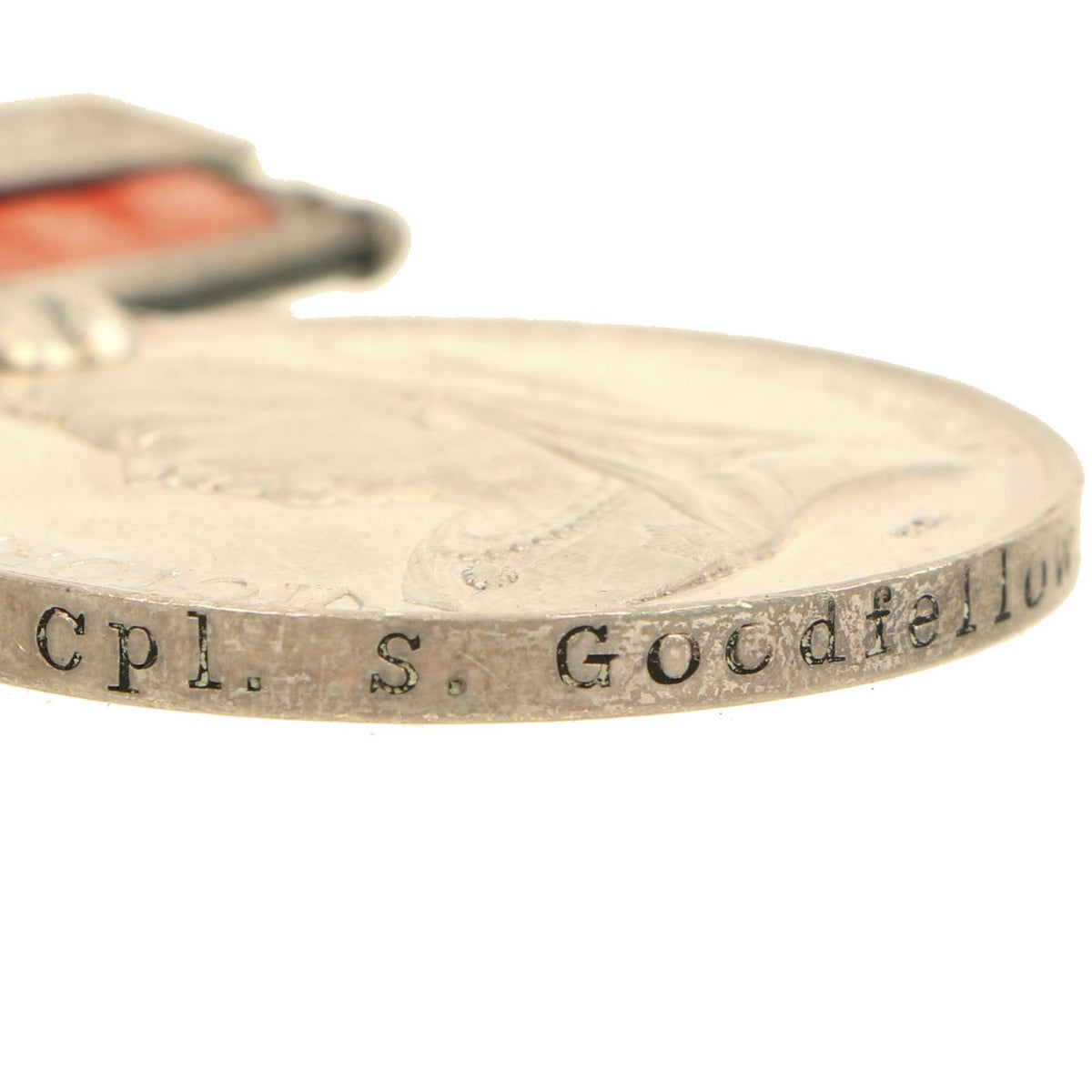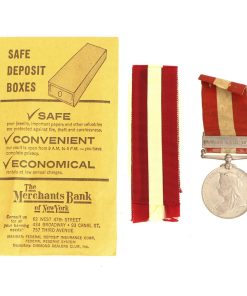Original Canada General Service Medal with Fenian Raid 1870 Clasp Named to Corporal S. Goodfellow – 50th Battalion Huntingdon Borders Original Items
$ 595,00 $ 178,50
Original Item: One-of-a-kind. The Battle of Eccles Hill or (The War at the Border) was part of a raid into Canadian territory from the United States led by John O’Neill of the Fenian Brotherhood, intended to pressure Great Britain to grant sovereignty to Ireland. In 1870, the Fenians crossed the Canadian border and proceeded to the top of Eccles Hill where they were confronted by members of the Canadian home guard and volunteers. The Fenians were overwhelmed by local militia units and armed citizens on May 25, 1870, and were compelled to abandon what was anticipated to have been a “glorious victory”.
The Canada General Service Medal was a campaign medal awarded by the Canadian Government to both Imperial and Canadian forces for duties related to the Fenian raids between 1866 and 1871. The medal was initially issued in 1899 and had to be applied for. This example is offered in excellent condition and includes a FENIAN RAID 1870 Clasp.
The rim of the medal in impressed to read:
Cpl. S. GOODFELLOW, 50th. Bn.
The 50th Battalion Huntingdon Borders
Simultaneous with Gen. O’Neil’s raid into Canada at Eccles’ Hill on May 25th, an invasion took place on the Huntingdon border, when a strong force of Fenians under command of Generals Starr and Gleason advanced about a mile and a half into the Province of Quebec, on the line of the Trout River. On arrival at a chosen position which possessed great advantages for a successful defence, they began throwing up entrenchments, and prepared to make a determined stand. A whole day was spent in the work of constructing rifle pits and breastworks, but being no doubt discouraged by the news of O’Neil’s defeat at Eccles’ Hill, they abandoned their position on the 26th and returned to their camp on the American side of the line. While there they evidently received some encouragement and reinforcements, as they returned to their entrenchments in Canada early on the morning of Friday, the 27th of May, and re-occupied their works, which they busily began to strengthen. Their rifle pits were dug in front of some hop-fields, defended by stockades, with a stout barricade across the road. The line of entrenchments rested on the river on one side and a dense wood on the other, while their centre was strongly protected by a forest of hop-poles, through which their retreat, in case of necessity, would be comparatively safe. The whole position was chosen with considerable skill, and was so strong that 500 men could easily have held off several thousands for a considerable length of time, had they been properly directed.
The Canadian force chosen to operate against this column of the enemy was composed of H. M. 69th Regiment, the 50th Battalion (Huntingdon Borderers), and the Montreal Garrison Artillery, the whole under command of Col. Bagot. At 3 o’clock in the morning of the 27th, the Montreal Garrison Artillery and the Huntingdon Borderers were ordered on the march from Huntingdon Village, where they had arrived the previous night. In less than two hours the whole force was on the move along the road leading to Holbrook’s Corners. At 8 o’clock the entire column had reached Hendersonville, which is two miles from Holbrook’s, and there one company of the Montreal Garrison Artillery (under Capt. Rose) was ordered to proceed along the concession road to the west in order to flank the enemy, whose glittering bayonets were plainly visible in the sunlight as they were drilling in a field about a mile and a half distant.
The advance guard of the Fenians were posted behind a very strong entrenchment, with their right flank resting on the river and their left covered by the woods. Their skirmishers were about 150 in number, and their supports and reserves (amounting to about 300 or 400 more) were stationed a short distance in the rear.
The Huntingdon Borderers formed the Canadian advance guard, and as soon as they had approached within about 300 yards of the Fenian position, were deployed in skirmishing order, and advanced with great gallantry. The centre support was composed of one company of the 69th Regiment, under Capt. Mansfield and Lieut. Atcheson. The remainder of the 69th, under Major Smythe, was drawn up in quarter distance column as a reserve. One company of the Montreal Garrison Artillery (under Capt. Doucet) marched across the bridge and along the road on the left, and afterwards took part in the engagement with those who had been sent in the opposite direction further back, to prevent a flanking movement from either side. The remainder of the Artillery and Engineers, under Capt. Hall, marched to the front as a reserve, but afterwards returned to Holbrook Bridge, which it was feared the Fenians might attempt to capture, and advance along the south side of the river. The skirmish line advanced with great steadiness against the enemy behind the entrenchments. The Fenians fired three volleys as they advanced, the fire being promptly returned by our men as they gallantly moved forward. When the Canadians came within 100 yards of the entrenchments, the Fenians fell back through the hop-field, firing as they retreated, and when they got beyond its protection, ran for the buildings further back, where it was thought they would make a stand. Col. Bagot then ordered Capt. Mansfield’s company of the 69th to fix bayonets and charge, which was done in grand style, amid loud cheering, and resulted in the complete rout of the Fenians. Capt. Hall’s Battery of the Montreal Garrison Artillery, directed by Lieut. Fitzgeorge, cleared the wood on the left in a very thorough manner, and soon the whole Fenian army were in a helter-skelter race out of Canada and back to American territory. When the Canadian troops reached the boundary Col. Bagot had great difficulty in restraining them from crossing into the United States after the fugitives, so eager were they to effect the capture of the marauders. The Fenians were so swift in their retreat that only one was captured, but three men were killed and several wounded during the fight. No losses occurred among the Canadians.
The Fenians were utterly dispirited and completely demoralized, and when their commanders (Gen. Starr and Gen. Gleason) were arrested at St. Albans by the United States authorities on the following day, they abandoned all further thoughts of invading Canada, and left for their homes thoroughly sick of their experience on their excursion to Trout River.
At Buffalo, Detroit, Ogdensburg, and other points where Fenians had gathered for the purpose of invading Canada, the news of the fizzles at Eccles’ Hill and Trout River caused consternation and depression among their ranks, and the fact that Gen. O’Neil and several others of their military leaders were in jail on serious charges, served to put an end to all thoughts of continuing the movement, and they hastily dispersed and returned to their homes.
Gen. O’Neil was brought to trial some time after by the United States Government, on a charge of violation of the Neutrality Laws, and was sentenced to six months’ imprisonment. This was a hard blow to the Fenian organization, and it gradually went to pieces.
But the warlike spirit had not died out in O’Neil, and he began to plan new ideas. His hatred of British institutions appears to have been so deep-seated that he was willing to sacrifice not only his liberty, but life itself, to undertake any scheme that had for its object their overthrow, and it was not long before he was again implicated in a plot against the Dominion of Canada.
Shortly after his release from prison in 1870, he entered into a conspiracy with emissaries of the rebel Louis Riel to assist in a great uprising in the Canadian Northwest, in which the Indians and half-breeds were to be utilized. O’Neil was ready for anything, and consented to invoke Fenian aid in conjunction with Riel’s rebellious plans, by participating in an invasion of Manitoba. He managed to obtain a few hundred stands of breech-loading rifles and a quantity of ammunition that had escaped seizure by the United States authorities at the time of the Fenian Raid of 1870, and with the assistance of Gen. J. J. Donnelly, he fitted out an expedition on the Minnesota frontier. He started from Port Pembina, Minn., on October 5th, 1871, to invade Manitoba and raise his standard, but had barely crossed over the boundary line when he was arrested, with his troops. All of their armament was seized and they were marched back as prisoners to Pembina and handed over to the United States authorities. They were indicted on charges of breach of the Neutrality Laws, but at the trial were acquitted on some slight technicality.
This ended Gen. O’Neil’s career as a filibuster, and becoming disheartened and discouraged by his failures, he began drinking heavily, and soon became a wreck, subsequently dying alone and miserable as the result of his excesses, “unwept, unhonored and unsung.”
Fast Shipping with Professional Packaging
Thanks to our longstanding association with UPS FedEx DHL, and other major international carriers, we are able to provide a range of shipping options. Our warehouse staff is expertly trained and will wrap your products according to our exact and precise specifications. Prior to shipping, your goods will be thoroughly examined and securely secured. We ship to thousands clients each day across multiple countries. This shows how we're dedicated to be the largest retailer on the internet. Warehouses and distribution centres can be located throughout Europe as well as the USA.
Note: Orders with more than one item will be assigned a processing date depending on the item.
Before shipping before shipping, we'll conduct a thorough inspection of the items you have ordered. Today, the majority of orders will be delivered within 48 hours. The delivery time will be between 3-7 days.
Returns
The stock is dynamic and we cannot completely manage it because multiple stakeholders are involved, including our factory and warehouse. So the actual stock may alter at any time. It's possible that you may not receive your order once the order has been made.
Our policy is valid for a period of 30 days. If you don't receive the product within 30 days, we are not able to issue a refund or an exchange.
You can only return an item if it is unused and in the same state as the day you received it. You must have the item in its original packaging.
Related products
Uncategorized
Uncategorized
Armored Burgonet Helmet & Polearm from Scottish Castle Leith Hall Circa 1700 Original Items
Uncategorized
Uncategorized
Uncategorized
Uncategorized
Uncategorized
Uncategorized
Uncategorized
Uncategorized
Uncategorized
Uncategorized
Uncategorized
Uncategorized
Uncategorized
Uncategorized
Uncategorized
Uncategorized

